

When the new solution from ATI appeared on the scene, new RADEON 9700 based accelerators began arriving from ATI's partners. Before reading this review we recommend that you read the earlier published articles on this product.
As we can see, ATI has finally started mass supplies of video cards based on its new flagship, and the chips are also delivered to its partners. But such models are pure copies of the reference sample, they are actually produced on the same plant.
If you remember half a year ago the situation was the same. The RADEON 8500 cards which started flooding the market at that time look identically and differed only in stickers. It was obvious that according to the partnership strategy of ATI first time the partners received the whole video cards, instead of just chips, produced by Chinese company PC Partner by request of ATI Technologies. Of course, the production facilities of even such a giant as PC Partner were not sufficient, and the cards were in short supply, especially 275MHz models.
Should we expect the same situation now? I guess yes. Taking into account a complicated design and not very powerful production facilities of the ATI's partners or even a dearth of them I think the RADEON 9700 Pro will be in very short supply. At present such cards are delivered only from ATI and its partner Sapphire which is a daughter enterprise of PC Partner. Well, the creator have the right to skim the milk.
That is why we should expect a copy of the reference card even from Gigabyte which is known for its maverick approach in developing cards. But for a user it's even better to have entirely identical cards based on the RADEON 9700 Pro as this brings no compatibility problems, and even if they take place, ATI will try to solve them as fast as possible as they affect everybody.
I'm very pleased that the RADEON 9700 Pro appeared at the prices much lower than the ATI recommended ones ($399). According to www.pricewatch.com the minimal price of the GeForce4 Ti 4600 cards of companies dealing with world-wide deliveries is $235 (Albatron), the maximum one is $260 (Leadtek). We took data from the shops where the cards were available at the stores at the same prices. Let's add $15 for unexpected expenses; the average price is thus $262.
The minimal price for the RADEON 9700 Pro is $337, and the cards were available at the stores. The maximum acceptable price is $350. Let's add $15, and the average price is thus $358. So, the newcomer is 37% dearer than the 3D king GeForce4 Ti 4600. And what about the performance? According to our previous tests the RADEON 9700 Pro outscores the GeForce4 Ti 4600 without AA by 24.2%, with AA by 105%, with anisotropy by 103%, and with AA and anisotropy by 108%. Well, the price difference is overlapped by the performance boost. Note that we haven't examined the DirectX 9.0 yet as the API and drivers for the DX9 are not released yet. Moreover, the RADEON 9700 has excellent DVD-video and TV-out, that is why the card will certainly gain wide popularity.
But recently NVIDIA has released a new driver which boosted up the performance considerably of the GeForce4 Ti cards and some others. We will see how the positions of the cards change with the new 40.41 driver, but I should warn NVIDIA's fans that there are still a lot of problems NVIDIA are to cope with.
And now let' turn to the card itself.
 |
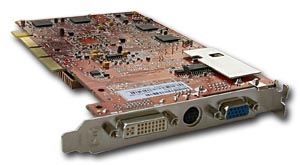 |
| The card comes with Samsung memory K4D26323RA-GC2A, BGA form-factor. The highest speed is 350 (700) MHz, that is why the access time is 2.8 ns. The default speed is 310 (620) MHz. | 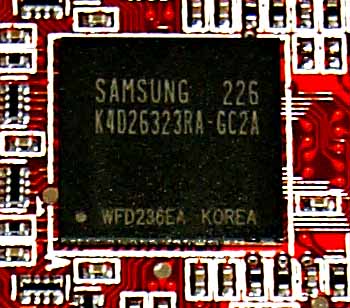 |
The memory chips in the new BGA package are very popular among card
makers and we won't touch upon their advantages anymore.
| Gigabyte MAYA II R9700Pro 128MB | |
 |
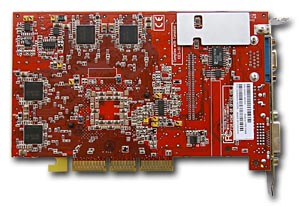 |
| Reference card ATI RADEON 9700 Pro 128MB | |
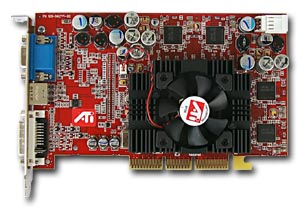 |
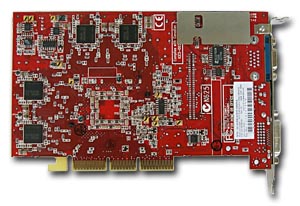 |
This is a copy of the reference card. The design is usual and it has become more complicated because of the 256bit high-speed bus (that is why until production of such expensive PCBs is mastered by the manufacturers all RADEON 9700 Pro will be as like as two peas in a pot).
The card is equipped with standard interface connectors: VGA, DVI and TV-out (S-Video). There is a special adapter to connect TV-out via RCA (very small and without a cable).
The heatsink on the chip differs from the reference one, though it's also big. Moreover, the desire to cool down everything that heats up is still strong and Gigabyte has covered the memory with heatsinks as well.
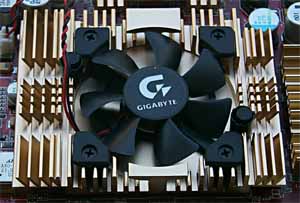
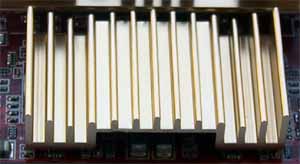
Due to such power consumption it's dangerous to apply such load to the circuits that feed the AGP on mainboards, that is why the RADEON 9700 has an external power source via a connector like in case of a Floppy disc drive. If you do not connect it and turn on the computer you will see the following:

| Gigabyte MAYA II R9700Pro 128MB | 325/620 -> 375/680 MHz |
|
Note that such overclocking was possible earlier but the memory refused
to work even at its rated frequency (350 MHz). It seems that it was purposely
reduced to 310 (620) MHz.
Note:
 Test system and driversTestbeds:
In the tests we used ATI's drivers 6.159 (this driver showed that unification of the drivers for the RADEON would be extended as it supported RADEON 9700 and RADEON 8500. Probably with the software release INF files will be supplemented with data on other chips/cards). VSync was off, texture compression was off, all texture detail settings were set to maximum (High Quality) both in Direct3D and in OpenGL (in the latter case the default detail level is not the highest, that is why we had to make the respective changes). For installation of the OS on the SIS 648 based system we used AGP drivers 1.11 (the latest version for the beginning of September). The following cards are taken for comparison:
Driver settingsIn our previous review we described the settings ATI offered. Remember that today only the DirectX 8 drivers are available! The DirectX 9.0 drivers are expected to come only in October.Test results2D graphicsWhat can we say about 2D? Traditionally imperfect quality of NVIDIA based cards (though quite often it's a monitor to blame...). Traditionally top notch quality of ATI's samples (but it was at the time when the Canadian company produced all cards itself). Taking into account that the RADEON 9700 is now made in full accordance to the developer's requirements we can be sure that the high 2D level will retain in the cards from ATI's partners!The colors are very rich. On the whole, we are very pleased with 2D quality. As I mentioned plenty of times, estimation of 2D quality is subjective. Quality depends on a sample, as well as on the card/monitor tandem. And first of all you should pay attention to quality of the monitor and cable. TV-out, DVD-Video, multimonitor supportThe card comes with several adapters, including S-Video-to-RCA. We used the latter to enable a TV-out: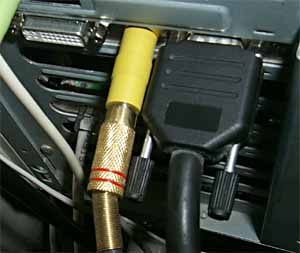 The driver now allows activating TV-out. We spoke a lot about such settings in the reviews on RADEON 8500 based cards. Thanks to the dual-monitor support the RADEON 9700 is able to display an image on TV without detriment to the image on the PC screen, you even don't have to reduce a resolution to 1024x768. However, the normal dual-monitor support works only on two monitors as a TV resolution will coincide with that on the monitor. But as the TV-out is limited by 1024x768, at a higher resolution the TV screen will display a floating window of 1024x768. On the whole, the TV image is of very good quality: 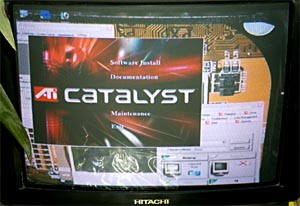 The Clone, Extended modes are also supported on the TV-out, that is why you can watch movies, for example DVD, on TV. You can deceive the players which do not let you move a movie window to TV: you can interchange the monitor and TV in the driver settings so that you can watch a movie on TV and have a blank desktop on your monitor:  Unfortunately, the latest version of the HyperSnapDX doesn't allow capturing screenshots from DVD movies, that is why I can't demonstrate quality of deinterlacing. The ATI Multimedia Center 7.8 supplied with the card entirely supports the technologies of the RADEON 9700 and provides excellent quality. But it's unclear whether FULLSTREAM and shader technologies can be used. It's announced that only the RealOne player supports it (which is meant primarily for the Internet - on-the-fly video playback). I haven't noticed difference between the ATI MMC 7.8 and RealOne Player (even when watching old MPEG1 files), but the ATI MMC takes only 16% of the processor's resources, while the RealOne uses it by 25%. Let's wait for new software versions with FULLSTREAM supported. 3D graphics, 3DMark2001 - game testsWe used two testbeds as the SIS 648 mainboard allows us to enable the AGP 8x of the RADEON 9700. But so far we have noticed no difference between 4x and 8x on this stand. Even under the great load on the card. Below you will see diagrams for the SIS 648 only in the 3DMark2001. Believe us, in the other tests the difference between AGP 4x and 8x is absent.3DMark2001, 3DMARKS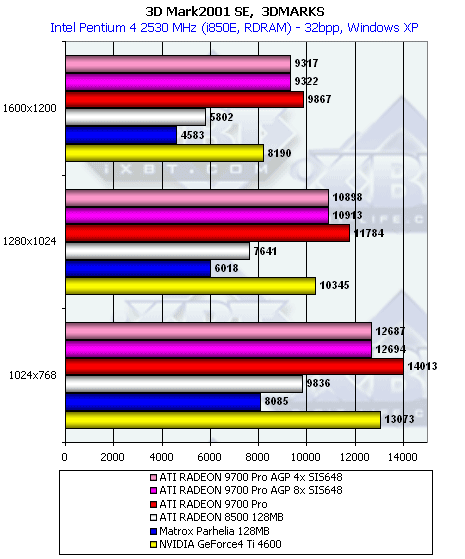 Last time we compared performance of the RADEON 9700 Pro and the leading NVIDIA GeForce4 Ti 4600. Today we will continue the comparison and show how the situation changes with the new NVIDIA's drivers. Note that in the tests with the enabled AA and/or anisotropy the cards are loaded by 100% and the CPU's influence is not great. Last time the RADEON 9700 Pro outscored the GeForce4 Ti 4600 by 17 -
39%, and now the breakthrough is just 7 - 20.5%.
3DMark2001, Game1 Low details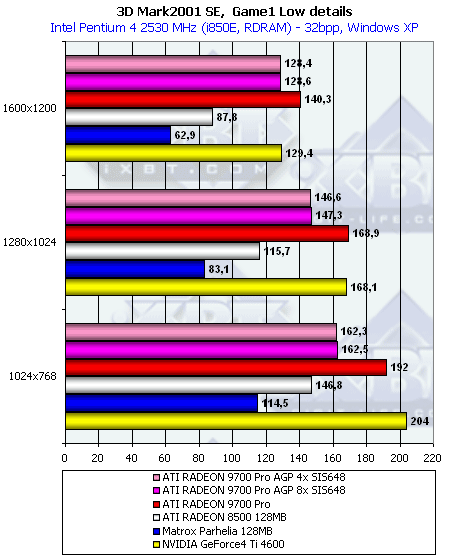
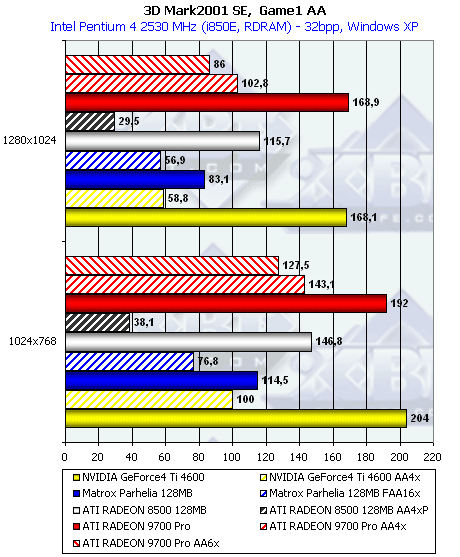 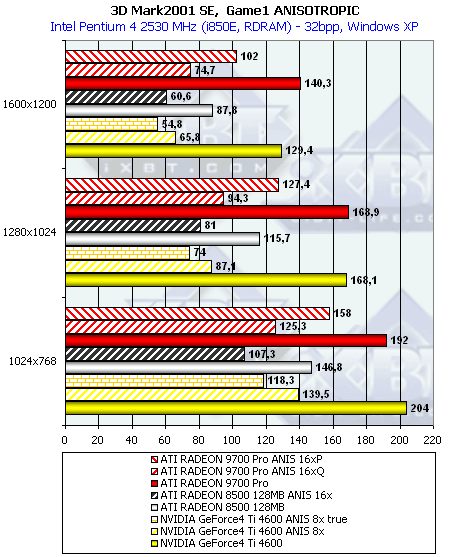
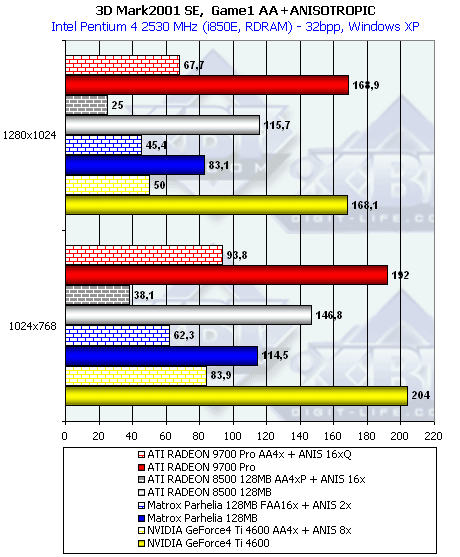
3DMark2001, Game2 Low details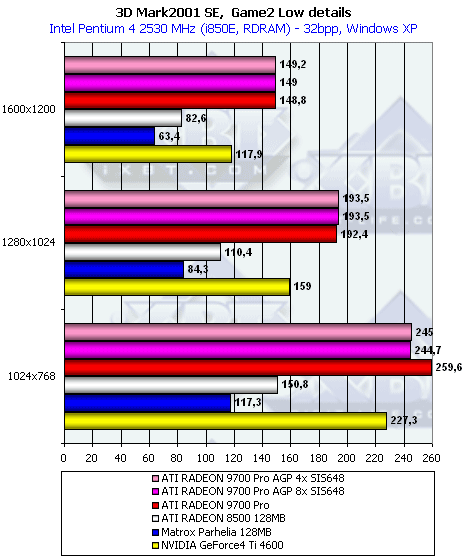
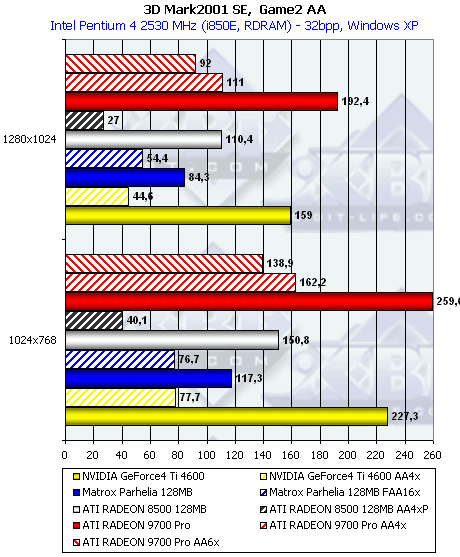 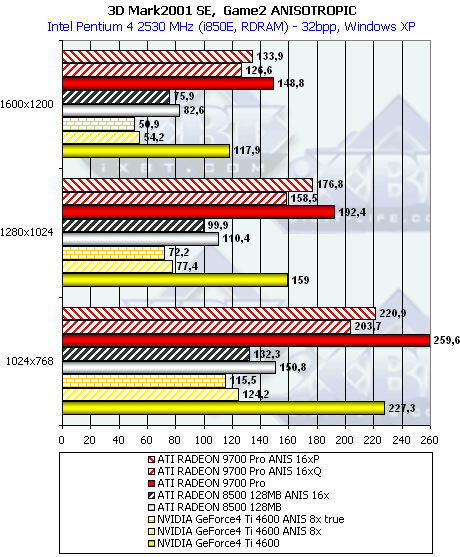
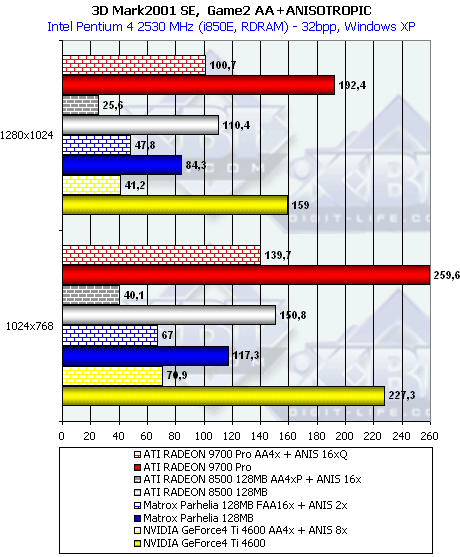
3DMark2001, Game3 Low details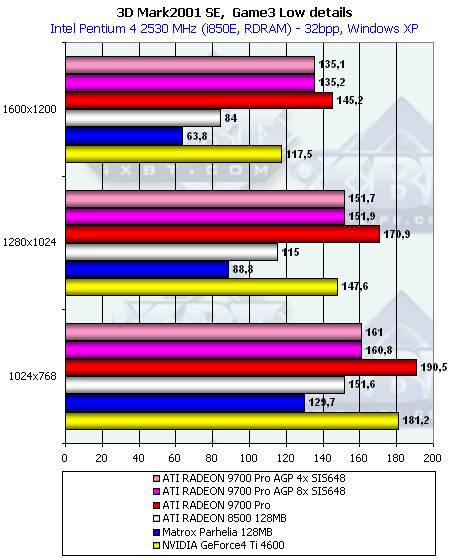
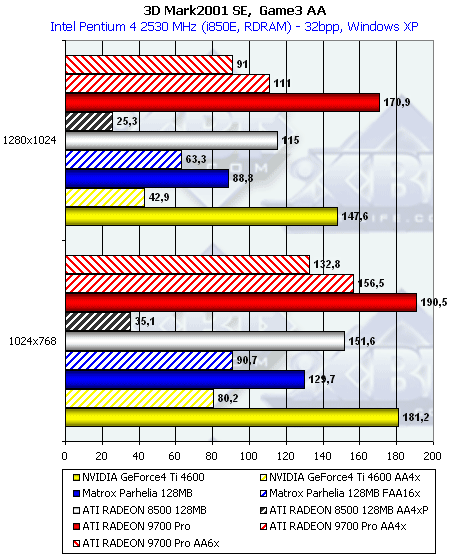 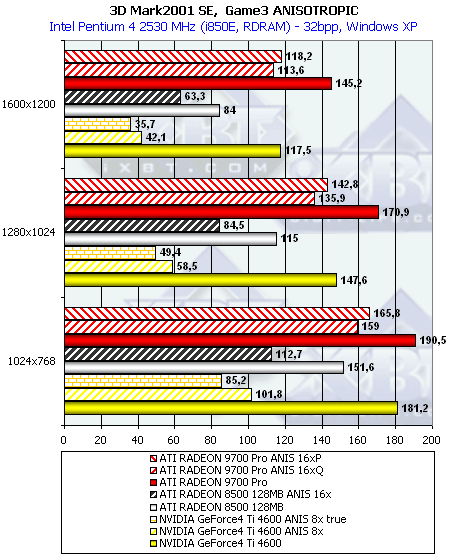
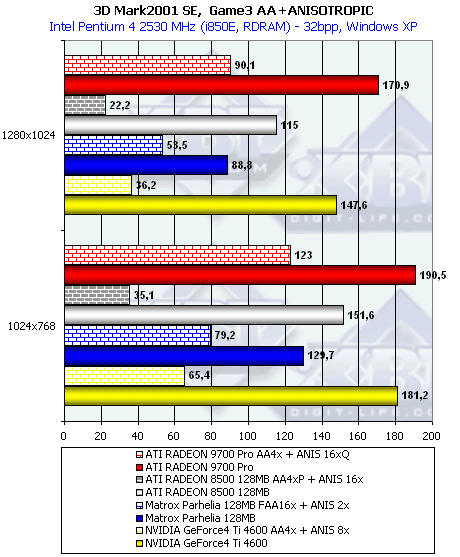
3DMark2001, Game4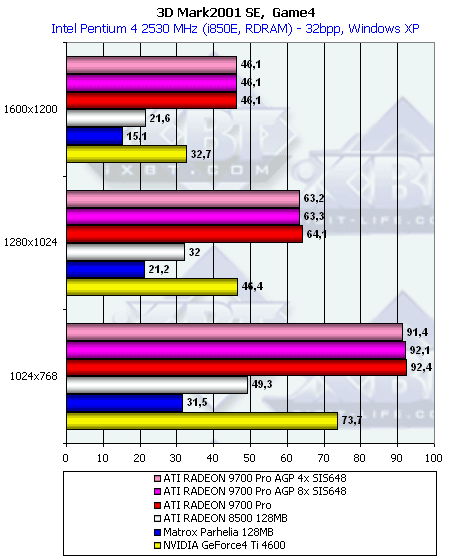
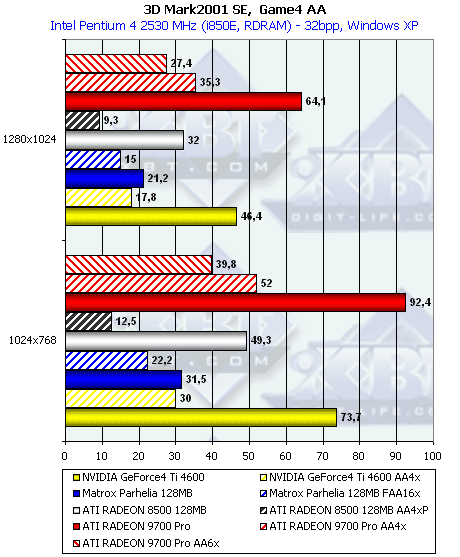 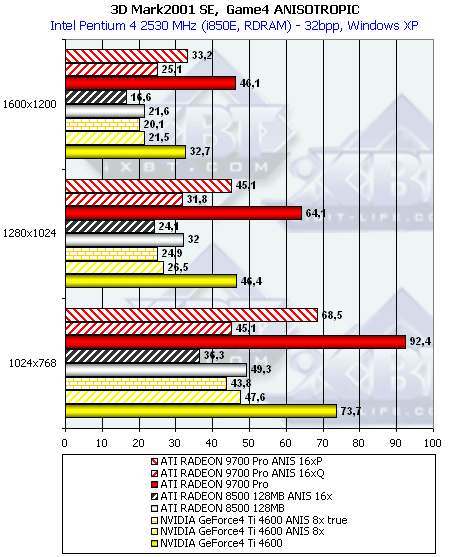
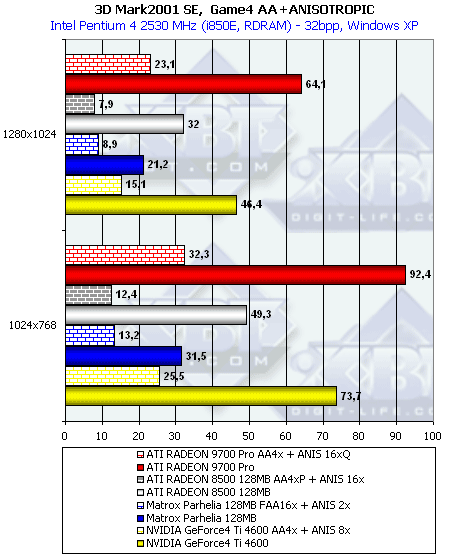
Comments:
3D graphics, game testsFor the performance estimation we used:
Quake3 Arena, Quaver
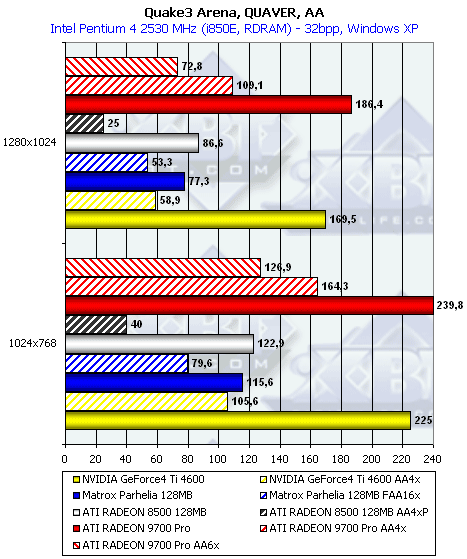 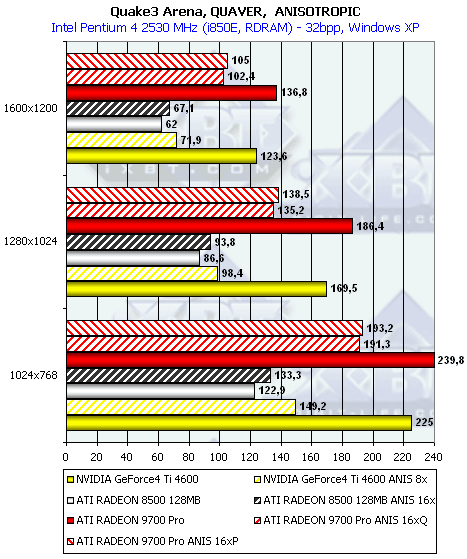
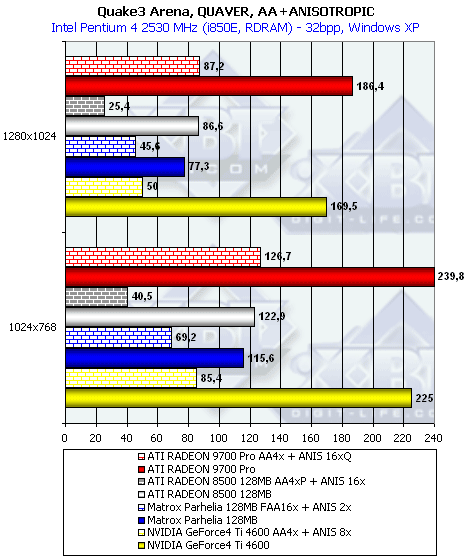
Thanks to the new NVIDIA's driver the Ti 4600 managed to catch up with the RADEON 9700, but the gap is still great especially in the heavy tests. Serious Sam: The Second Encounter, Grand CathedralHere are the screenshots with settings:
 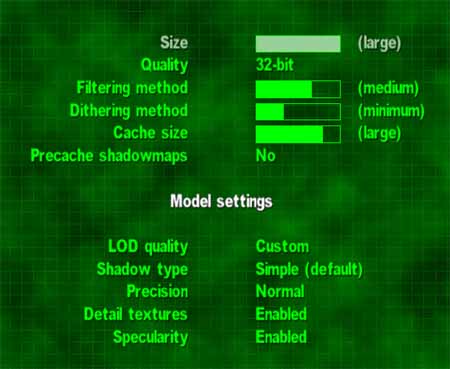
 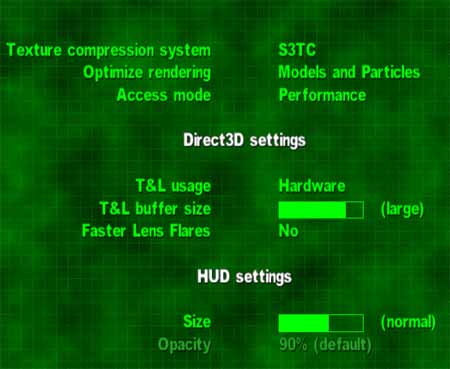
 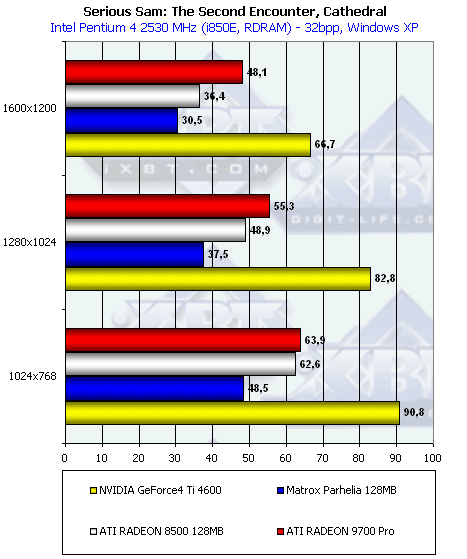
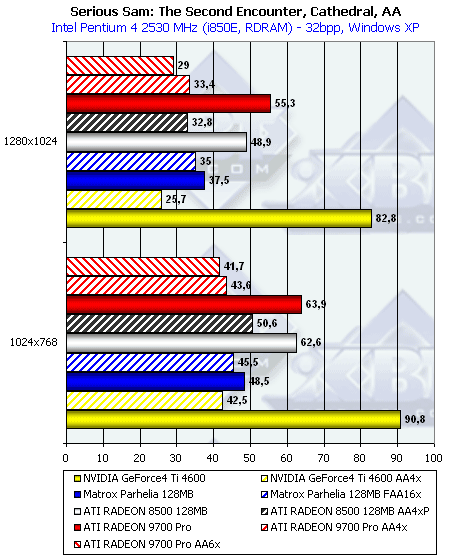 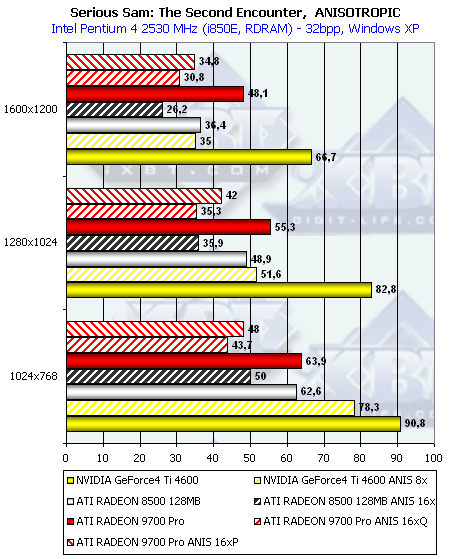
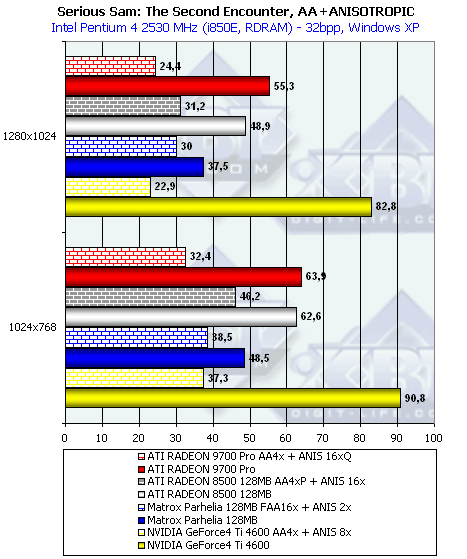
As I mentioned last time it's either the ATI's driver that works terribly in this game, or there is something else that prevents the RADEON 9700 from showing its might. I pin my hopes on the new drivers or at least on explanation from ATI. Return to Castle Wolfenstein (Multiplayer), Checkpoint

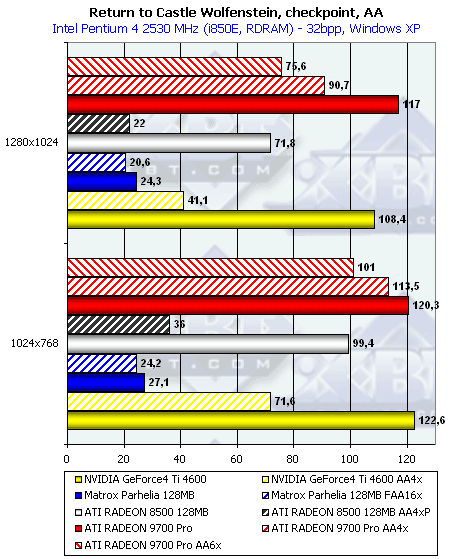 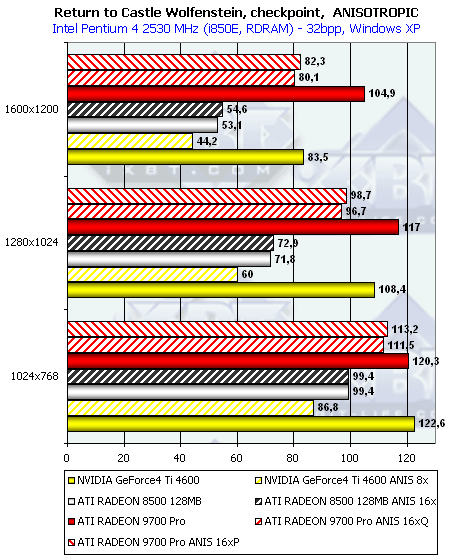
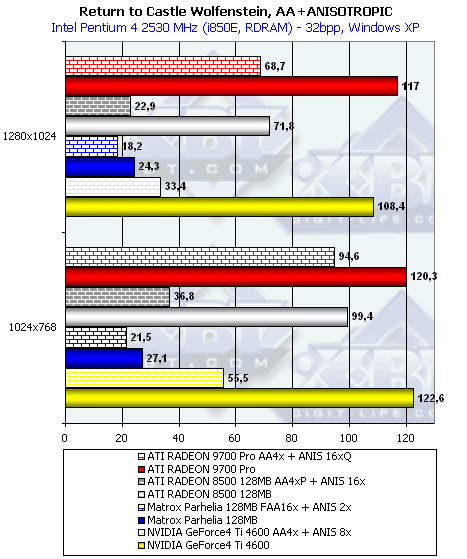
This test doesn't worsen the scores of the ATI's solution as much as in the other tests. Code CreaturesThis test is based on the CodeCult's engine which is used for several games.The engine enables almost all modern capabilities of video cards of the latest generation. And the demo program based on this engine contains quite tough scenes as to the texture size, geometry and effects used. 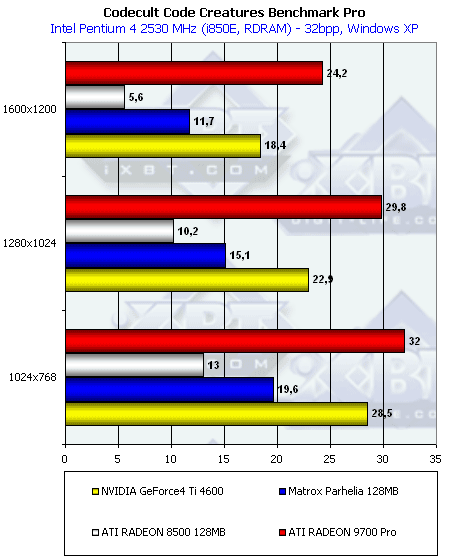
No comments. Comanche4 DEMO
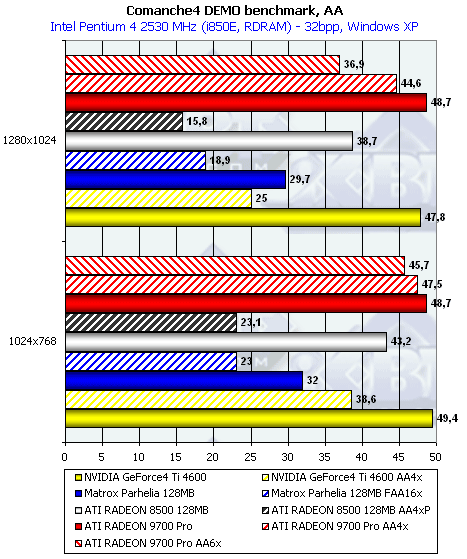 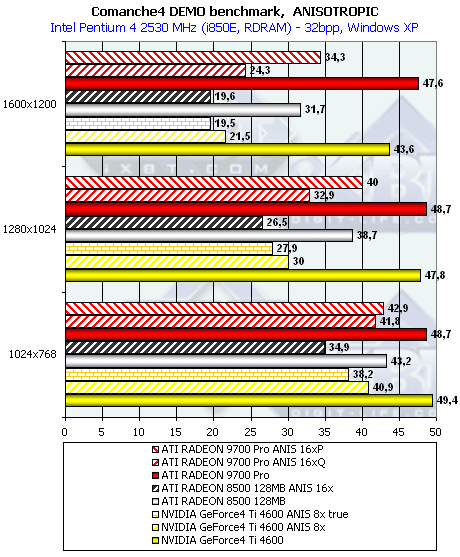
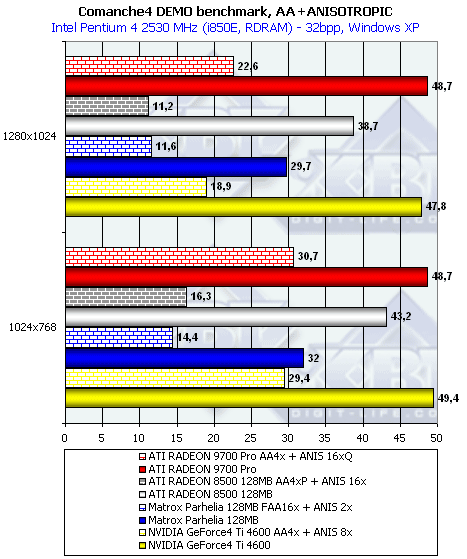
A processor affects much this test, and the load on the cards is very high, that is why the overall performance is low at the maximum quality level. That is why even a 50% gain is a great achievement, and RADEON 9700 often has more. Unreal Tournament 2003 DEMO b.927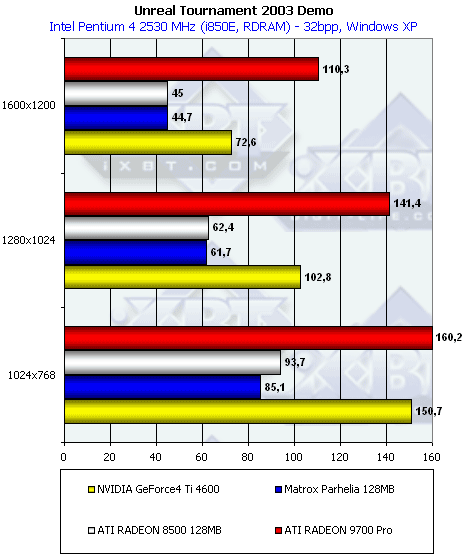
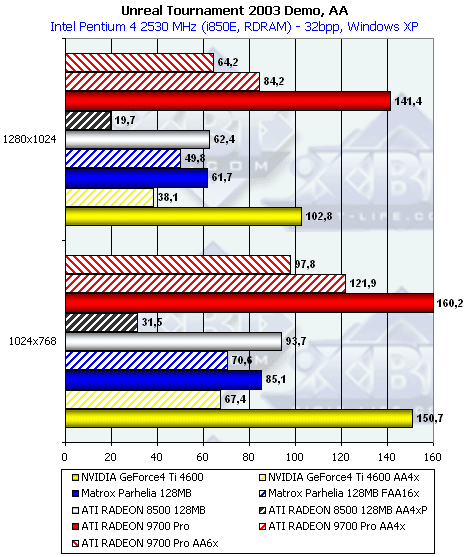 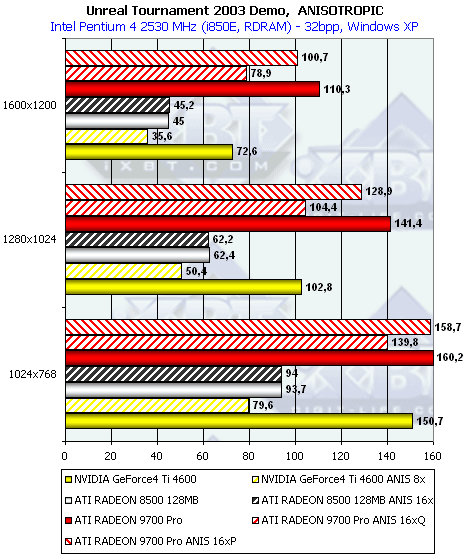
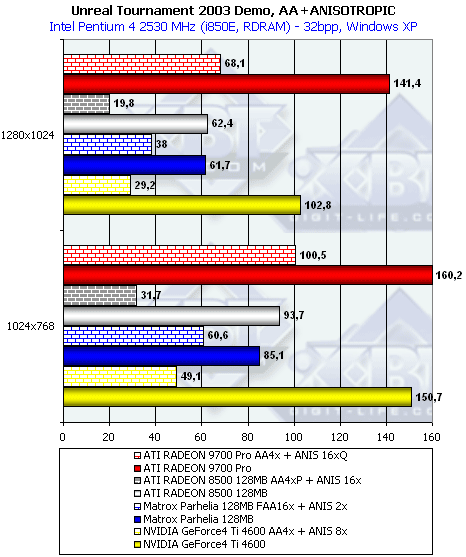
This test puzzles many, but we decided to leave it here until the final DEMO version is released. Yet in our 3Digest we wrote that performance of the ATI's cards was unexplainable. But even in such a sad position the RADEON is able to break down the resistance of the game and take the lead again. Dashes in the table mean that the data obtained last time were incorrect, though the tests were carried out several times (probably the Demo was raw). AquaMark
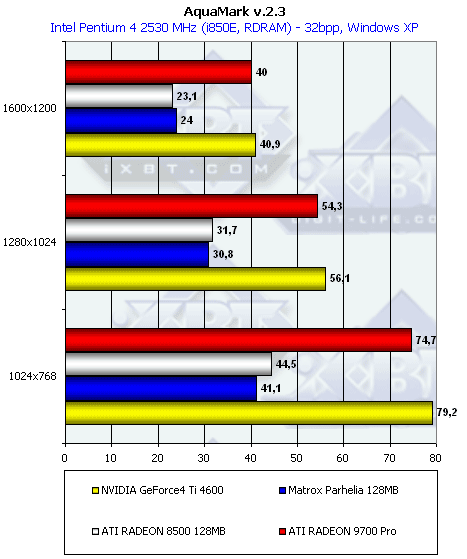
RightMark 3D
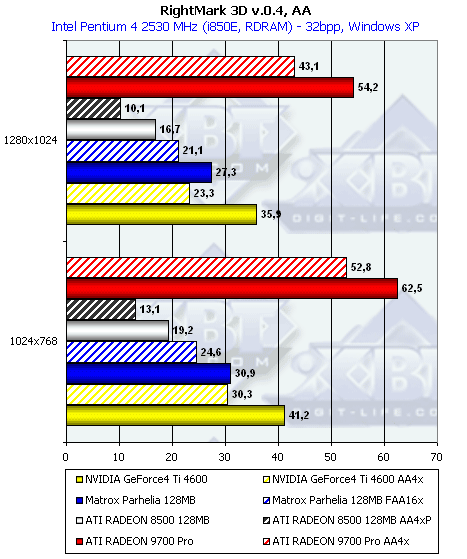 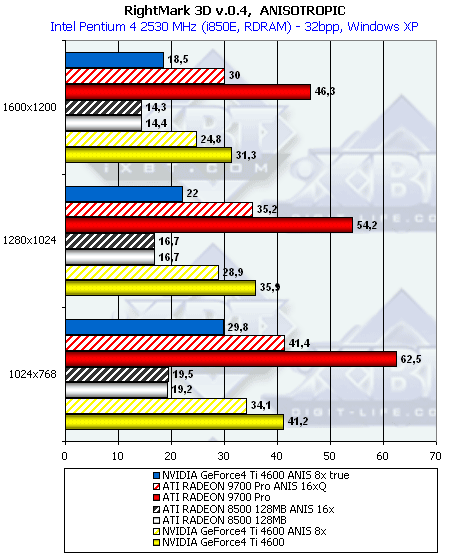
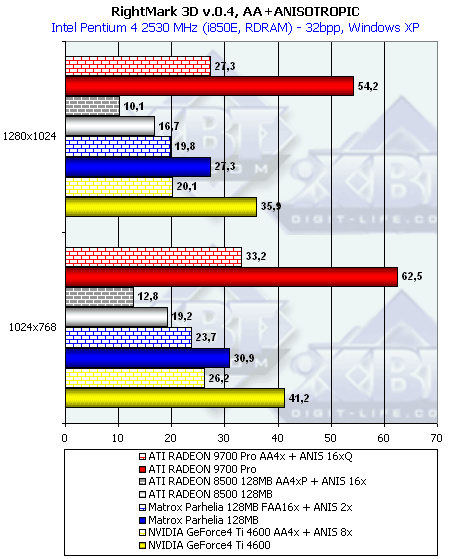
This test is very complicated as it examines operability of modern accelerators with the DX8.1 functions enabled and their speed. And the RADEON 9700 copes with it excellently. Now let's draw a conclusion on the performance in general. Before testing on the new platform and with the old NVIDIA's driver 30.82 we wrote: According to our previous tests the RADEON 9700 Pro outscores the GeForce4 Ti 4600 without AA by 24.2%, with AA by 105%, with anisotropy by 103%, and with AA and anisotropy by 108%. Well, the average price difference of 37% is overlapped by the performance boost. The new results are: the RADEON 9700 Pro outperforms the GeForce4 Ti 4600 without AA or anisotropy by 15.8% ON AVERAGE, with AA by 94.2%, with anisotropy by 62.8%, with AA and anisotropy by 64.4%. Although the gap is smaller, the figures still look astounding. Again the average price difference of 37% between the RADEON 9700 Pro and the GeForce4 Ti 4600 (on the US market) is made up for by the might of the ATI's card. Moreover, we still don't know what new ATI's drivers are going to offer us. It should be noted that with the anisotropy enabled at the maximum level 8 in the 40.41 drivers the advantage of the RADEON 9700 could be lower if we didn't change settings of anisotropy in Direct3D in the drivers. The Level 8 in the panel of settings actually mean Level4. And the true maximum level can be set only through the RivaTuner or the registry. We marked this mode on the diagrams as "ANISO 8x true". And exactly these figures were used for comparison of the RADEON 9700. 3D qualityQuality of the anisotropic filtering in the new NVIDIA's drivers will be studied in one of the future reviews of GeForce4 Ti cards. And now we will take a look at quality of 3D graphics of the RADEON 9700 and GeForce4 Ti 4600 on the old (30.82) and new (40.41) drivers to make sure that the performance boost is obtained not at the expense of quality. |
||||||||||||||||||||||||||||||||||||||||||||||||||||||||||||||||||||||||||||||||||||||||||||||||||||||||||||||||||||||||||||||||||||||||||||||||||||||||||||||||||||||||||||||||||||||||||||||||||||||
| We don't show screenshots from Morrowind obtained with the ver.29.42
as they are included in our 3Digest.
But for some mess in the 3DMark: Game 1 both cards have equal quality irrespective
of the NVIDIA's drivers (contrary to a wide opinion that the quality with
the 40.41 drivers is much worse). The Game 1, according to the developers,
has a lot of things of random nature, that is why sometimes a car can simultaneously
be viewed at a bit different angles; secondly, the NVIDIA's drivers always
have problems with shadows in this test.
We have shown the screenshots from Morrowind on the 40.41 just to make sure the graphics quality doesn't get worse on this game with these drivers of the GeForce4 Ti. The tests let us know that the drivers 40.41 are optimized only for the GeForce4 Ti and possibly for the GeForce3 as well. And there are a lot of problems with other cards; many complain about TV-out, quality etc. with the new drivers. But the need to put obstacles on the way of the RADEON 9700 made NVIDIA to release the raw drivers 40.41. But I don't think this will stop the ATI's procession. ConclusionThe RADEON 9700 is an absolute champion. Moreover, I think that the developers from ATI will response to NVIDIA with new drivers with a good optimization without quality losses.
As far as the Gigabyte's card is concerned, we have nothing to say about its peculiarities as it's based on the reference design. I hope this Taiwanese trade mark will get even more popular when potential users of the MAYA II buy and work with this solution. At last, maybe the NVIDIA NV30 will replace the RADEON 9700 on its throne
by the end of autumn, but...
Andrew Worobyew (anvakams@ixbt.com)
[an error occurred while processing this directive]
|